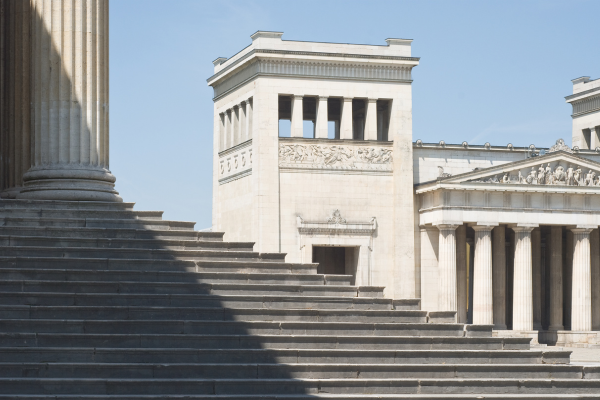.png)
Reviving Classics in Modern Architecture
Picture this: walking down a city street, modern skyscrapers soaring on one side, while on the other, a beautiful classical building stands with grace and poise. It's like time travel on a single block. Classical architecture, with its rich details and storied past, uniquely captures our hearts, even in our modern, fast-paced world. But why do these old-world designs still resonate with us today? Why are architects blending classic with contemporary? Dive in with me as we explore the enduring charm of classical architecture and its place in our 21st-century lives.
Historical Context of Classical Architecture
Have you ever wondered where classical architecture started? Let's take a brief journey back in time.
Classical architecture takes us back to ancient Greece and Rome. These weren't just buildings; they were reflections of society's ideals. The Greeks loved balance, beauty, and order. Just think about those iconic columns and marbled temples. They weren't just for show; they represented harmony and perfection.
Then came the Romans. They were inspired by the Greeks but added their own twist. They introduced grand arches and domes, showing off their engineering skills. These buildings were about power and the greatness of the Roman Empire.
Now, why does all this matter today? Because the heart of classical architecture is about more than just design. It's about values, dreams, and society's aspirations. These buildings tell us stories of what people valued most back then: beauty, balance, and grandeur.
So, when we see classical designs today, it's like a whisper from the past. It's a reminder of where we've been, what we've learned, and the timeless values that still touch our hearts.
The Emotional Resonance of Classical Architecture
Have you ever looked at an old building and felt a sudden rush of emotion? There's something about classical architecture that tugs at our heartstrings. It's like hearing a familiar song from long ago, bringing memories and feelings.
Classical architecture, with its grand columns, elegant domes, and intricate details, isn't just about bricks and stones. It's a story—a tale of our shared history. The designs connect us to times when every building was a masterpiece, and every detail told a part of humanity's story.
In today's fast-paced digital world, we often crave connections. We want something that feels real, lasting, and genuine. Classical buildings offer that. Amid the glass and steel of modern cities, an old-world structure stands as a comforting reminder of our roots. It tells us stories of when buildings were more than places to live or work. They were symbols of our values, dreams, and hopes.
In essence, the charm of classical architecture isn't just in its beauty. It's in the feelings it evokes. It's a bridge to the past, reminding us of where we came from and who we are. And in a world constantly changing, that emotional anchor is something many of us deeply cherish.
Psychological Effects of Classical Architecture
Ever walked into a building and instantly felt... different? That's the magic of architecture. But classical designs have an extraordinary power over our minds.
Think about it. Something is calming about walking through an old-world-styled hallway with grand columns or looking up at a high dome. It's not just pretty; it affects how we feel.
Classical architecture, with its symmetry and order, brings a sense of balance to our minds. It's like everything is right in the world, even just for a moment. The spaciousness, the natural light, and the echoes of footsteps make us feel connected, rooted, and at peace.
Then there's the material. Natural stone, wood, and marble make us feel close to nature. It's grounding. We feel safe and sheltered.
In contrast, imagine a modern glass and steel skyscraper. Sleek, yes. But does it make you feel the same warmth and comfort? Maybe not.
In essence, classical designs tap into deep feelings in us. They remind us of timeless values, of nature, and of balance. And in today's fast-paced world, that touch of calm and connection is something we could all use a little more.
Societal Impact of Classical Architecture
When you stroll down a street lined with classical buildings, do you feel a sense of pride? Many of us do. That's because these structures aren't just bricks and stones; they shape the soul of a community.
There's a certain vibe in towns and cities with preserved classical buildings. These places often become hubs for art, culture, and social events. Think about local theaters in classical structures or cafes in old-world-styled buildings. They become community favorites.
These buildings also tell stories. They speak of our history, our growth, and our collective memories. Children grow up hearing tales of what happened at these iconic spots, and those stories shape their sense of identity.
Plus, let's remember tourism. Travelers love to visit places that have a rich history and distinct character. Classical architecture became a draw, boosting local businesses and the economy.
In a way, these timeless structures bridge the gap between the old and the new. They unite people, fostering a sense of shared history and community pride. And in today's ever-changing world, that's a genuinely precious bond.
Public Perception of Classical Architecture
What comes to mind when folks see a classical building? Do they see it as just another structure or something more? Let's talk about how everyday people view these timeless designs.
For many, classical buildings are like a breath of fresh air. Amidst the sea of modern structures, they stand out. They remind people of simpler times, stirring feelings of nostalgia. Some might think of classic movies or romantic tales set in historical places. Others might remember childhood trips to museums or historic sites.
However, some people need to be on the same page. Some might see these buildings as outdated, longing for sleeker, modern designs. They might argue that we're in the 21st century, and our architecture should reflect that.
Yet, even with varied opinions, there's no denying the buzz these structures create. Whether it's a debate about preservation or a community event at a historic site, classical architecture gets people talking.
And that's the thing — these buildings spark emotion and conversation. They become landmarks, selfie spots, and stories to tell. Love them or not, they're part of the community tapestry, shaping how we see our surroundings and connect with our past.
Adapting to Modern Needs While Honoring Tradition
In a constantly changing world, architects have a unique challenge: how do you keep the old while embracing the new? Classical architecture has charm and history, but today's world has different needs and tools.
So, how do we blend the two?
Today's buildings need to be practical. They need to stand firm against time and weather. While ancient builders used marble and stone, modern architects had more options. Think about materials like concrete, steel, and even bamboo. They're flexible and solid and can give that classical look a fresh twist.
But it's not just about materials. Modern life is different. We like open spaces, oversized windows, and lots of light. The good news is that these modern tastes can fit with classical style. Think about a house with big, open rooms but with the elegance of classical pillars and arches. It's the best of both worlds!
And let's remember technology. With the latest software, architects can play with designs in new ways. They can see how old-world charm can mix with new-world comfort. This means better planning and fewer surprises.
In short, the beauty of the past doesn't have to stay in the past. With some creativity, we can bring it into today, giving us spaces that are beautiful and perfect for modern living.
Economic Benefits of Classical Architecture
Have you ever considered how those grand old buildings might add dollars and cents to a town? It's not just about looks; classical architecture has real economic perks.
First off, think tourism. Folks love visiting places with character and charm. Classical buildings? They're like magnets for tourists. People come, snap photos, grab a bite to eat nearby and stay a night or two. That's money flowing into local businesses.
Next, consider property values. Areas with well-preserved classical buildings often see higher property rates. These buildings are like the crown jewels of a neighborhood, making the whole area more desirable.
And let's remember jobs. Restoring and maintaining these classics? That takes skilled workers. Craftsmen, artisans, and experts are all needed, which means more job opportunities.
Plus, these buildings are often repurposed in creative ways. An old bank might become a trendy restaurant. A historic home could turn into a boutique hotel. These ventures bring in revenue and breathe new life into the community.
So, next time you admire a classical building, remember: it's not just a feast for the eyes. It's also fueling the local economy in more ways than one.
Case Studies: Melding Old with the New
There's a beautiful dance that happens when the past meets the present. In architecture, some modern projects capture this dance perfectly, blending classical style with today's flair. Let's take a closer look at a couple of these gems.

The Pearl in San Antonio, Texas: Remember old breweries? The Pearl was one. Today, it's lively with restaurants, shops, and even a riverside amphitheater. But here's the charm: while sleek, modern buildings exist, the old brewery's essence still stands strong. Its brick walls and historic details are preserved, reminding visitors of its rich past. It's where you can sip a fancy coffee in a setting that feels straight out of the 1800s.

The Apple Store at Carnegie Library, Washington D.C.: Not every day, you walk into a tech store in a historic building. But Apple made it happen. With its grand pillars and classical detailing, the Carnegie Library became home to one of Apple's stores. And yet, the tech giant ensured the library's character was recovered. Instead, they blended it with their modern design, making shopping feel like a walk-through history.
These are just two examples, but they tell an important story. Classical architecture can thrive in our modern world. With creativity, respect for the past, and a touch of innovation, old-world charm can meet today's style, creating spaces that inspire and intrigue.
Conclusion
Classical architecture is more than just a throwback to the past. It's a testament to timeless beauty, solid craftsmanship, and the stories that shaped our communities. As we've seen, there's so much value in blending the elegance of yesteryears with the vibrancy of today. From boosting local economies to sparking conversations, these historic designs have their own magic. As we move forward, let's celebrate these gems and recognize how they enrich our modern lives. After all, there's something special about standing in a place that bridges the gap between where we've been and where we're headed.
.png)

